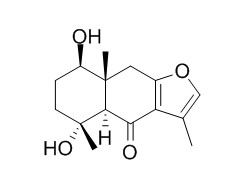Curcolonol
Standard reference
Inquire / Order:
manager@chemfaces.com
Technical Inquiries:
service@chemfaces.com
Tel:
+86-27-84237783
Fax:
+86-27-84254680
Address:
1 Building, No. 83, CheCheng Rd., Wuhan Economic and Technological Development Zone, Wuhan, Hubei 430056, PRC
Providing storage is as stated on the product vial and the vial is kept tightly sealed, the product can be stored for up to
24 months(2-8C).
Wherever possible, you should prepare and use solutions on the same day. However, if you need to make up stock solutions in advance, we recommend that you store the solution as aliquots in tightly sealed vials at -20C. Generally, these will be useable for up to two weeks. Before use, and prior to opening the vial we recommend that you allow your product to equilibrate to room temperature for at least 1 hour.
Need more advice on solubility, usage and handling? Please email to: service@chemfaces.com
The packaging of the product may have turned upside down during transportation, resulting in the natural compounds adhering to the neck or cap of the vial. take the vial out of its packaging and gently shake to let the compounds fall to the bottom of the vial. for liquid products, centrifuge at 200-500 RPM to gather the liquid at the bottom of the vial. try to avoid loss or contamination during handling.
Sichuan Agricultural University2023, 4630743.
Anticancer Res.2020, 40(10):5529-5538.
The Journal of Korean Medicine2022, 43(3): 79-93.
Huazhong Agricultural University2022, pp34.
Aging (Albany NY).2021, 13(19):22867-22882.
Phytomedicine.2023, 120:155063.
Evid Based Complement Alternat Med.2017, 2017:1583185
iScience.2024, 4790628.
ACS Omega.2021, 6(36):23460-23474.
J Pharm Pharmacol.2022, rgac033.
Related and Featured Products
J Nat Prod. 1998 Dec;61(12):1531-4.
Cytotoxicity of curcuminoids and some novel compounds from Curcuma zedoaria.[Pubmed:
9868158]
METHODS AND RESULTS:
Bioassay-directed fractionation of an EtOH extract of Curcuma zedoaria led to isolation of an active curcuminoid, which was identified as demethoxycurcumin (2) by comparison of its 1H and 13C NMR spectra with literature data and by direct comparison with synthetic material. Curcumin (1) and bisdemethoxycurcumin (3) were also obtained. Curcuminoids (1-3) were synthesized and demonstrated to be cytotoxic against human ovarian cancer OVCAR-3 cells.
CONCLUSIONS:
The observed CD50 values of 1, 2, and 3 were 4.4, 3.8, and 3.1 microg/mL, respectively. Three additional novel compounds, 3, 7-dimethylindan-5-carboxylic acid (4), Curcolonol (5), and guaidiol (6), were also isolated from the EtOH extract. The structures and relative stereochemistry of 4-6 were determined by spectroscopic methods and X-ray crystallographic analysis.
Yao Xue Xue Bao. 2005 Jun;40(6):525-8.
Studies on the chemical constituents from the roots of Chloranthus henryi.[Pubmed:
16144317]
To study the chemical constituents of the roots of Chloranthus henryi.
METHODS AND RESULTS:
The constituents of Chloranthus henryi were separated with various chromatographic techniques. structures were elucidated by physico-chemical properties and spectral data.
Eight compounds were isolated from Chloranthus henryi. They were identified as Curcolonol (I), zedoarofuran (II), shizukanolide E (III) , skimmin (IV), calucanthoside (V), chloracoumarin (VI), beta-sitosterol (VII), daucosterin (VIII).
CONCLUSIONS:
Chloracoumarin (VI) is a new compound and characterized as 6,8-dimethoxy-7-O-[beta-D-apiofunanosyl(l --> 3 )-D-glucopyranosyl]-2H-benzopyran-2-one. Compounds I, II were isolated from Chloranthus henryi for the first time.



